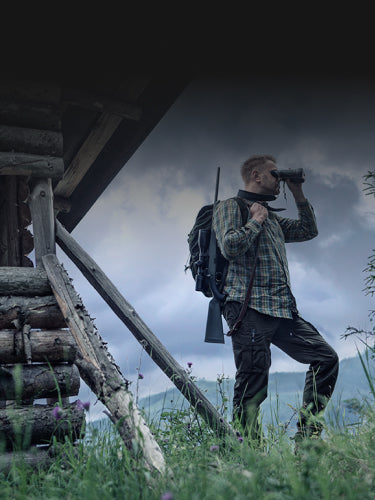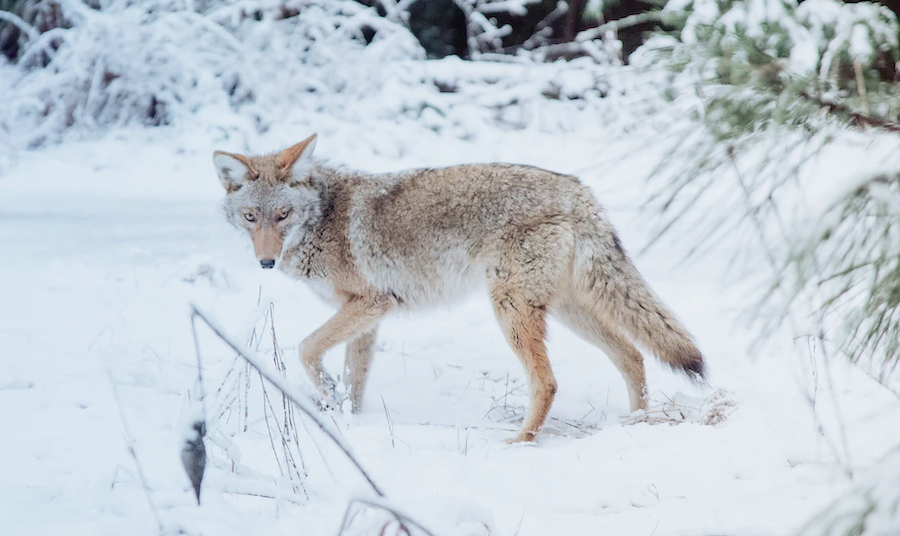The illusive song dogs of the American south are opportunistic predators who use their cunning and heightened senses to track their prey, which is what makes them so hard to hunt. The coyote (canis latrans) is many things to many people. To some, especially shepherds and ranchers, it is nothing more than a dangerous pest wreaking havoc on livestock. Professional trappers see them as walking investments, and while the art of the furrier isn’t what it once was thanks to environmental activism, a high-quality coyote pelt can still sell for about $30-$40. On the opposite end of the spectrum, the Navajo revere the coyote as the amoral trickster god, existing from the beginning of time along with the First Man and First Woman, and somewhere in the middle, the casual hunter just thinks they’re fun to shoot.
Hunting coyotes is not the same as hunting deer. While both creatures have heightened senses of smell and can run faster than an Olympic athlete on a good day, Wile E. and his kin have much better night vision than Bambi and are much more cunning.
A coyote has 20/75 vision, while a deer has 20/100. This means if a human with perfect vision can see an object clearly at 75 feet, a coyote would need to be 20 feet away to see the same object clearly. A human with either of these acuities would need prescription glasses, but just because we humans can see further does not necessarily mean we’ll notice them before they notice us.

Thanks to the way their eyes sit in their sockets, a coyote has wider cones of vision. As predators with long snouts, they have a 260° cone of vision compared to a human’s 180°, meaning that they have better peripheral vision than we do.
It is often stated that most huntable animals like deer, hogs, and coyotes are colorblind, but this is not exactly the case. Their spectrum of colors is more limited than ours, but they should technically still see color. Red, orange, and green are beyond the visible spectrum of a coyote, however they can detect ultraviolet light, which is normally invisible to humans. This is important to remember if you hunt with freshly laundered clothes, since detergents that use fluorescent brightening agents like diamino stilbene disulfonic acid, fluorescent brighteners, fluorescent white dyes, or any detergent with the word “fluorescent” in the ingredients make your clothes stand out to a coyote, even they look perfectly camouflaged to you.
On a related note, the same fluorescent dyes also make you glow when being viewed through night vision equipment. If you still want your camo to work but don’t want to be given away by your awful, unnatural smell, consider using activewear detergent which works without any fluorescent brightening agents.
Where the coyote’s vision truly shines – literally – is at night. Multiple sets of glowing eyes in the darkness are usually the telltale signs of a pack of coyotes. This eerie phenomenon is caused by a layer of natural reflective tissue over a coyote’s eyes called the tapetum lucidum. Absent in humans, this membrane allows the eyes of nocturnal animals to collect more light, acting as a form of natural night vision lenses.
However, like dogs, coyotes tend to rely more on their sense of smell than their sight. A completely blind coyote can still smell blood from about a mile away, and the average “effective range” for a coyote’s sense of smell is 350 yards. If you are upwind of a coyote and inside that 350-yard radius, the coyote will very likely bolt. With 26 square inches of an olfactory zone and 220 million olfactory sensors compared to a human’s 400, the coyote’s sense of smell acts as an omnidirectional radar constantly searching for threats and targets of opportunity.
Hunting the Coyote
So then, it falls to the hunter to engage this animal when the wind is in favor, at long range. Since coyotes are active at night, the use of thermal imaging is not only recommended but required for engaging targets at the distances required for nighttime coyote hunting. While there are some flashlights capable of beaming down on a yote from several hundred feet away, their sheer brightness would make it seem like an alien counter to the coyote, and using high quality thermal imaging would allow hunters to see further and shoot with better accuracy.
The Talion XQ38 has an effective range of 1475 yards, but unless you’re blasting coyotes with a precision rifle capable of long-range shooting, it would be better for you to engage at ranges of 300 yards or less to ensure an ethical shot to the coyote’s vitals.
Now, a .223 with a ballistic tip is a good choice if you want rapid expansion, but unless the round hits bone on the other side, you’ll have an enormous exit wound that’ll ruin your pelt, if that concerns you. If not, all center-fire rounds with flat trajectories are suitable for coyote hunting.
However, if you want to preserve your pelt to sell, or if you’re interested in taxidermy, a .17HMR will do the job. This small, fast round will leave a small entry wound, and its exit wound – if any – will be far less gruesome than a larger centerfire round like a .223.

Scouting and Optics
Before you can kill any coyotes, you’ll have to know they’re even in the area. Be on the lookout for paw prints (generally 2.5 to 3.5 inches long) and droppings. Dark coyote dung means an abundance of meat in the area, and coyotes who are eating well have no reason to forage frequently, so there is less chance of seeing them. Lighter dung indicates slim pickings for the coyote, which means they’re more likely to respond to calls.
Using a mapping system like onXmaps, you can determine elevation points in your hunting area and hike to them to scout from a higher vantage point. Using a Merger LRF XP50 and its 1800-meter (2,000 yard) detection range, you’ll be sure to see any coyotes out in the open, even in pitch darkness.
If you do happen to find coyotes after the sun goes down – and you likely will, since they are more active at night – Use the Talion XQ38 for your riflescope. This powerful thermal riflescope has 9 hours of battery life for a full night of hunting, a 1,475-yard detection range, 2.5x base magnification for a wide field of view, and 10x magnification for closer shots.
Luring is the most effective way to hunt them. If you are down wind of the coyote and well-camouflaged enough, it is possible to get a shot in at 50 yards.
At this range, No. 4 buckshot with copper plated BBs, tightly patterned, would do the trick.
When calling, your scope – especially if you’re using thermal – should be kept on its lowest possible magnification setting to increase your peripheral vision. If possible, use the Merger to scan your surroundings before looking through your Pulsar optic of choice to deliver the kill. Avoid going closer than 4x until you are sure you have your target.
Coyotes are mostly active at night in search of game animals like mice and vermin. They prefer cooler temperatures for movement, 20° to 50° is what they consider comfortable.
Since most of their prey comes out at night, coyotes are mostly nocturnal. For the longest time, this limited coyote hunting to daytime hours alone, but with the latest developments in hunting technology such as digital thermal vision, more and more hunters are becoming adept at long range night hunting. This is especially important for farmers and ranchers who wish to keep their animals safe from coyote attacks.
What about you? How do you scout and hunt coyotes? What kind of optics do you use? Tell us in the comments below.




3 comments
Update: Continually night going; but at my own pace and schedule. No Boggies seen, but some heard just the other night, but at a very long distance. Tried different calls, and now putting out a decoy for the fun of it ( AKS: Realism aiding ). See tracks in the woodsy hollow. Fun……but no cupie doll.
I wonder how far a coyote can see a person sitting still in the open ? ( on a folding chair )
I wonder how far a coyote can see, if i move my arms while sitting down ?
Given on a cloudy overcast night ?
Given on a bright full moon night ?
My post seem solitary; I guess reflecting somewhat like Coyote Behavior !
Update: ( + 24 hrs ): Given: Ref: N W S Press Release = The Most Fog in the Most parts of U S A for most consecutive days Ever ( so Historic in my real of thinking/otherwise ). Went out last night and the venue/ambiance was historic for me ( in as such above ) ! It was a Cat # 1 with instrumentation; since could hardly see your hand as you extend your arm to the fullest outstretch. Imagine yourself in a thick cumulus cloud above the earth trying to locate/I.D. Song Dogs in a Beautiful Extra Large expanse of a green hay active farm meadow ( 900+ far woodline )
No " super bait popsicle visitors " in 3 hr sitdown ( blind/comfy chair/sturdy tri ) on Scanner. But Remarkably ( instrumentation/tecnology/research/development ) I could See ! Whell-La ! Surprise…( well only sorta….since I certainly expected since I did the read/print on XP 50 & Axion L R F capabilities ), and thought before setting out, " the=proof-is-in-the pudding ". I did spotted three deer grazing at 350 yds with mostly soupy fog. What Fun to extent your Hunt(s) when time is precious with the Right glasses
Stay Tuned: ( never posted before. except for yesterday by happenstance )
Also may I add: Need a charging cord (lost ) for my SightMark Tact Light # SS3000 ( SM73011 ) No gots at manufacturer/inventory by phone call to TX ). A Great Light at Night, but cant use
D H G
( Western New York )
Using XP 50, Axion LRF Scanner. Trying, but on a Major learning curve: which actualy is most Fun for me, Never shot one or At one; but I consider myself Very Conservative on the shot..( I have been told: Too, Too much so! ) Have actually viewed a few. Now trying Hept-Up 7 gal baitpopsicle ( with now temps in lower 40’s should slowly melt)
Use .22 Creedmoor Custom. First check yesterday = no sign. But 4 days ago fresh track in bordering hollow. Also Howling, just started up this week
D H G ( DieHardGobbler ) Western New York